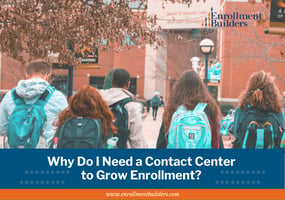Recently there’s been a drastic increase in traditional, regionally accredited, non-profit...
Enrollment Management Strategies: Optimize the Hand-Off
Conversion rates and capture rates in higher education are an important piece of online marketing. But there’s more to the enrollment management story than just what happens with marketing and lead generation. Successful recruitment and retention is all about the hand-off — managing inquiries from wherever they’re sourced, ensuring that all departments are working together and accountable for goals, and prioritizing student needs at every stage in the process.
Typically, the enrollment management process is divided into three departmental “buckets” of responsibility – marketing, recruitment, and retention. Though distinct in duties, each functional area is mutually dependent and the hand-off that occurs between them is crucial to the overall success of your school’s enrollment management efforts.
Conversion: The Hand-off Between Marketing and Recruitment
Between the marketing team and the recruitment team, conversion rate or inquiry-to-application rate refers to the number of leads that turn into applicants. Here, recruitment is relying heavily on marketing to identify the right student prospects. Similarly, marketing is relying on recruitment to reach out to students in a timely manner and to utilize appropriate follow-up strategies.
Successful hand-offs at this stage are built around communication and involve:
- Proper tracking of source codes. Tracking source codes and marketing campaigns is essential to gauge the effectiveness of various lead sources. This data drives a continuous feedback loop between the recruitment and marketing teams.
- An efficient feedback loop. The feedback loop provides a streamlined information exchange between recruitment and marketing, allowing marketing teams to identify those most likely to apply and adjust specific campaigns or realign resources.
- Regular departmental meetings. Scheduling regular, face-to-face meetings between representatives from marketing and recruitment helps both departments to spot trends, exchange feedback, and review conversion rates.
- Formal and informal communication channels. Helping team members understand the interdependent nature of their departments and promoting communication between staff is important. Consider reorganizing where your recruitment and marketing teams are physically located to encourage interaction and information sharing. Team-building exercises, quick daily status meetings, and other informal events can boost the collaborative spirit.
Capture: The Hand-off Between Recruitment and Retention
Between recruitment and retention, the capture rate refers to the number of registered students who complete the enrollment process and start classes. This number reflects how many students were successfully ‘captured’ from the point of scheduling/registration to the school’s official census date (the date of the final tally of enrolled students during a given term).
With this important transition, the recruitment team is counting on the retention team to help students as they acclimate to the life of the college so that students feel welcome and supported. The retention team is counting on recruitment to ensure the student has completed the application and financial aid processes. At this stage, successful hand-offs are driven by:
- Information gathering and exchange. A crucial part of the recruitment process involves gathering information about students. Both personal and academic, this information not only aids in recruitment, but it also forms the foundation of the retention team’s knowledge about each student too. Sharing the information effectively helps ensure a smooth hand-off and avoids unnecessary lag times.
- A personalized, student-centered approach. Similarly, as part of best practices, recruitment teams should note key details about each student — goals, motivation, interests, potential academic vulnerabilities, best times/methods for contact, etc. This information helps personalize the retention team’s approach to each student and avoid potential missteps. Especially with first-generation learners, this information can help retention teams intervene and reassure students at critical early points in their college careers.
- Hand-off meetings. A formal hand-off meeting between recruitment and retention is the perfect format to discuss all the key information mentioned above. It lets teams from both departments share information about students, identify issues, and properly scale resources.
Successful hand-offs are supported by dedicated teams talking to one another and helping each other be accountable. When marketing, recruitment, and retention professionals view enrollment management as a collaborative path rather than a set of distinct and isolated tracks, students win. Institutions can encourage this kind of thinking by making conversion and capture rates a part of performance goals and fostering a culture that supports information-sharing and less formal departmental boundaries.
Improve Your Strategic Enrollment Management Plan to Boost Enrollment
If you're like most admissions leaders, seeing an increase in your enrollment and retention means more than just improving the hand-off between teams. Sometimes it requires taking a look at your existing Strategic Enrollment Management (SEM) Plan to identify gaps and discuss how you'll address them.
Your SEM plan is the game plan that should cover everything from marketing and admissions to student services and financial aid. With a solid SEM plan, you can better allocate resources, enhance the student experience, and secure your learners' long-term success.
Ready to improve your strategic enrollment management plan? Read this article to learn the key components you need and download a free SEM Plan template: 7 Key Components of a Strategic Enrollment Management Plan
Helping your teams work together to improve enrollment management results is what Enrollment Builders is all about. If you’d like to find out more about how we can help with your school’s marketing, recruitment, and retention efforts, call us at 513-518-7824, or request information here.




